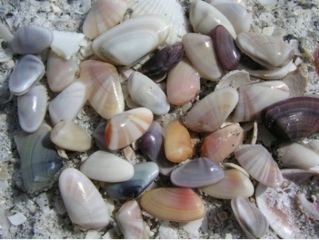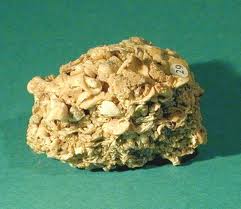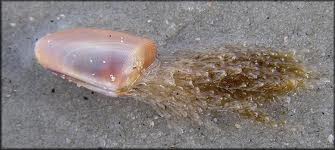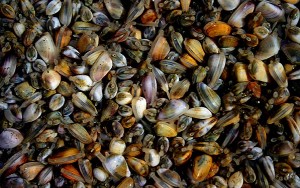Coquina: Donax: Good Eats
Ounce for ounce there is probably no more delicious seafood than Coquina. The problem is getting an ounce of it, so we usually settle for its fantastic, green broth.
Coquina (ko-KEE-nah) is a Donax (DOE-aks) a small, edible marine bivalve found through out the world. In the Americas, Indians collected them off the beaches, most notably along the Atlantic southeast and California coast, but they are also found from Long Island to Washington State to France, Australia et cetera. If you have a natural sandy beach with surf, you can have Donax.
The clam is rarely longer than half of an inch. It has two siphons that look like snorkels. One takes in oxygen and food, the other off loads waste. They live in colonies just below the surface of the sand in the area of the beach called the littoral zone, the area that’s usually exposed to the sun twice a day. Donax burrow into the sand at the edge of the surf so each incoming or outgoing waves can bring food. You’ll find them with Mole Crabs, which are also edible. (See a separate article on Mole Crabs. I have a video on both.)
In Florida the species is Donax variabili, locally called Coquina, whose shells make a soft rock for building. On the American Pacific coast it is Donax gouldii, locally known as Bean Clam or Wedge Clam. The Donax trunculus is found in France and is called Tellin, or Telline. The Australian Donax had a name change. It was Donax deltoides but is now called Plebidonax deltoides, known locally by many names: Pipi, Goolwa Cockle, Coorong cockle, Ugari and Eugarie. No matter what you call it, it still tastes great.
The only warning is they are subject to red tide like other mollusks, so don’t collect them if there has been a red tide until authorities say its safe. The next question is, how do you collect them, since they are tiny, usually about the size of your little fingernail. I’ve tried many ways and an old colander, a small shovel, and a bucket work the best.
Tidal changes are not great in Florida, so it has wide beaches that tend to be flat. That is where one finds Coquina, not where the waves crash ashore, but where they wash gently between high and low tide. In fact, each Coquina’s has what
looks to be a little bit of seaweed attached to one end and that pops up when a little water is over them and stays for a few seconds after the wave retreats. That is how one finds a bed of them. The smooth sand will be clear, a small wave comes in and recedes and you will see a multitude of tiny tuffs dotting the sand that then disappear into the sand. A shovel full of that sand usually produces hundreds of Coquina. Dump the sand into your colander, rinse the sand away, and dump the Coquina into your bucket, which has sea water in it. Of course, two people with two colanders works the best, one filling and one rinsing. You can easily collect gallons of them. The only odd part is they live in colonies, so you will go from patches of beach with them to patches without.
As for cooking….Rinse them very well; place in a pot with enough cold fresh water to almost cover the shells. Bring to a boil; reduce the heat and simmer a few minutes, 10 to 15 will do. Drain off the broth and serve. Cream and or butter enhances the flavor and it’s also great chilled. I think it is also the basis for a great potato puree. As for the tiny bits of meat…. they are edible, but it’s hard to separate from the little shells and often gritty. But I have eaten a lot of that, too. In Australia they apparently separate the meat commercially. I’d like to find an easy at home way of doing that.
Lastly, there is some humor in the naming of the Donax. It is among the smallest of edible shellfish, but Donax usually means a giant reed. There are two possible explanations. One is the donax was a large split reed (in two) and the little Coquina has two siphons. A more poetic view is “donax” means “a thing of beauty” and indeed the little shells are pretty. The species name, variabili means changeable, referring to coloration.







what do they eat coquina clams
Like other crabs and lobsters they are garbage collectors… they eat little bits of this and that.
We first ate coquinas at a restaurant in Barcelona called Cal Pep, where the pushy waiters didn’t want you to order them because they took too long to eat and slowed up turning the tables. Tiny, in a garlicky, winey broth, there were about 60 in a portion.
I’ve been finding them in the moist sand of NC beaches all my life; children are fascinated by them. We charged our grandchildren with collecting enough for supper, culled out the largest ones, soaked them in a cornmeal – dusted bath for 30 minutes (to encourage them to disgorge the sand), rinsed and drained. Sauteed garlic and red pepper flake in olive oil, added white wine and the coquinas, steamed covered just til they opened. Stirred in a couple of knobs of sweet butter and some italian parsley, they were delicious, briny and garlicky. Four ounces in the shell per person made a fun first course.
Ben,
made this recipe tonight, omitting the red pepper flakes and adding a generous squeeze of lemon and fresh basil instead of parsley… damned if that’s not the tastiest!
Made way too much though, so back into the pot they went with a half quart of water… now I have damn tasty stock! Liquid gold!
Before cooking do i deshell them or cook as is?
Cook them in their shells. They are difficult to deshell.
(Ditto of Mole Crab Comment Take Two)
WHERE & WHEN NOT TO HARVEST CRAB & SHELLFISH LINKS:
Florida HAB = Harmful Algal Bloom
Subscription Information
http://myfwc.com/research/about/information/subscription/
Before harvesting in Florida waters, determine open or closed status by visiting the Department’s Division of Aquaculture Web site …
http://www.floridaaquaculture.com/SEAS/SEAS_mngmt.htm
Click on District of below:
http://shellfish.floridaaquaculture.com/seas/seas_statusmap.htm
Florida Fish and Wildlife Conservation Commission
Red Tide Current Status
http://myfwc.com/research/redtide/events/status/statewide/
NOAA Harmful Algal Bloom Operational Forecast System (HAB-OFS)
http://tidesandcurrents.noaa.gov/hab/
UNESCO IOC Harmful Algal Bloom Website
http://www.ioc-unesco.org/hab/#
NOAA – NCCOS Harmful Algal Blooms & Analytical Response
http://www.chbr.noaa.gov/habar/eroart.aspx
Gulf of Mexico Dead Zone & Red Tides – explained
http://www.tulane.edu/~bfleury/envirobio/enviroweb/DeadZone.htm
My uncle-in-law is from Jordan. While ambling the white sands of Siesta Key, he’s been known to pick up coquinas and suck out the innards. Not really sure how well that works, and I never was brave enough to try it.
I found coquinas by the gob when a pup on Marco Island near 50 years ago. I used an orange/onion sack as a colander and cooked up a good mess. The resulting broth was great. I tired of trying to de-meat them though, and settled for straight broth. It would absolutely make a GREAT start to a clam chowder type soup. All this happened back when a family could still wander aimlessly around South Florida in a pickup/slide-in camper, and not be runn oft by the local law enforcement personal!! The road to Marco was a plank bridge at that time.
What great memories to have.
Ah, me too! Grew up in southern Florida and now think of coquina broth as “primordial soup.” Pushing sixty now, and still can taste it in my mind. Thanks!
I used to catch them by the handful, back in the early days at my home country (Venezuela). That was about 30 years ago. I remember them larger (about 1 inch in length) and wearing quite colorful shells. My sister and I made a rich broth by boiling them with a whole onion (for taste), fresh parsley (for décor) and salt. Let me tell you about delicious! Nowadays, they are hard to find, even in Venezuela. Those I have seen in US North East (i.e. Jones Beach, NY) are rather small ( about 1/2 inch) and very scarce in number. Yes, Deane! The coquina does bring great memories indeed.
I was very curious about the coquina’s “beard”. Looked it up and here is an excellent paper that explains it… symbiotic hydroid! (link failed) Sans hydroid, it seems that coquinas or telline seem to be eaten in italy sicily france australia etc.
I am hooked on your page it has lots of info I just joined into shell collecting. It a bucket of broken shells I found 3 tiny coquinas live . I’m a teacher and wanted to show the kids I my kinder class. How can I save them I had a water bottler with ocean water and sand, and the kids saw how they burry them selves in the sand. What sea animals are illegal to keep I know sand dollars are but what else.
I don’t know how to keep salt water creatures alive.
They come in every color of the rainbow, but not red????? Why cant you find a red coquina?
Go to St Pete beach around Treasure Island for these red beauties.
As for separating the meat, I find cooking them and then using a thumb works easily
25 years ago my two children and I were on St. George Island off of the Gulf of Mexico in Florida. We filled 2 gallon jugs with coquinas and took them to Alligator Point where there we none. NOW, you can walk the beach for many miles and see coquina shells in the surf. It gives us a great feeling knowing we did that deed.
I have lived both places and that is good that you did that. I grew up along the coast and I do not recall them ever being at Alligator Point, but that will sure be a help. I am guessing you are talking about the west end? The bay water on the east end would probably not sustain them. They like the salty water. Cool story!
They were 1950-1960 when we lived there.
Jeff I thnk I have already posted but wonder what happened to them. My family lived permanently on Alligator Point from 1950 about until 1960 and my grandmother and i collected them in abundance every year, one of my fondest memories of my time with her.
I use to take bunches of these on the Texas gulf coast with nothing but a shovel, colander and bucket but I used a trick to get rid of the grit. Cover the bottom of your bucket with a couple inches of very fine corn meal and then plenty of sea water. they’ll burrow into the corn meal and consume some of it, expelling their grit in the process. after a few hours, they’re sweet and grit free. I’ve been told the corn meal isn’t necessary and time and sea water will do just as well but I never did it any other way so I wouldn’t know.
My wife and i collect coquinas on padre island yearly. They are plentiful. Have used a collander, burlap sack, and even a wooden box with a slatted bottom designed especially for coquina collection. The collander is king for this job. The broth is really a nice treat.
In addition to “clam chowder” prepare spaghetti vongole with these clams after samplig that dish in a visit to Sicily: After washing them, cook them in olive oil with minced garlic and oregano until they open. Then add enough white wine to cover them and finish cooking for a few minutes. Add your cooked spaghetti to the mix. Sprinkle with parmesan cheese. I could eat this everyday. The warden at Silver Strand, Coronado said that you do not need a fishing license to harvest them, but when I showed them to him he did not seem to be familiar with these clams.
I grew up in Fl. And I too, have fond memories of the little buggers. We were fascinated by themy as children, but only ever wondered if we should eat them, imagining that tiny meant sweet. We called them sweet clams. Are they seasonal? I only worry about how to tell if any have died in the process. How can you sort the dead ones?”
Interesting comment about coquinas not being on Alligator point, my family lived permanently on Alligator Point from 1952 until 1960. My grandmother and I gathered them every year, she made a wonderful soup and I saved the shells they were very plentiful during that time. One of my fondest memories.
Thanks for the informative site! My kids gathered these “shells” and four days Lester they opened up with an awful stench. Now I know they were alive! Whoops.
I have made chowder out of these (we called them periwinkles) for years. we used a window screen to capture them and a fine strainer to filter the sand after boiling. We actually removed the meat with small knife blades and made a New England style chowder. Incredible!
Anyone know when the good times are to collect these in the Corpus Christi area? I was at Whitecap Beach in the middle of May and could pull up a handful of these fellas at will. I didn’t know they were such a delicacy though!
Coquina are good for hours of fun watching them burrow in the swash zone. The “beard” is not part of the bivalve, but a symbiotic hydroid named Clytia. You might be interested in my book “Naturalist’s Guide to the Atlantic Seashore”.